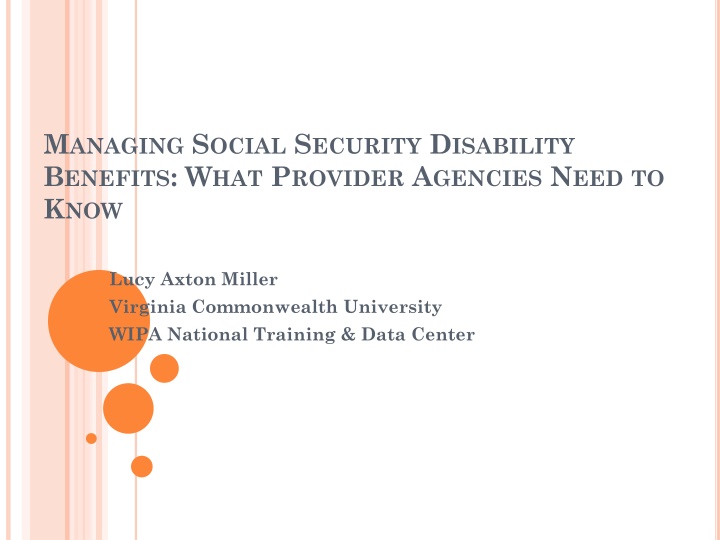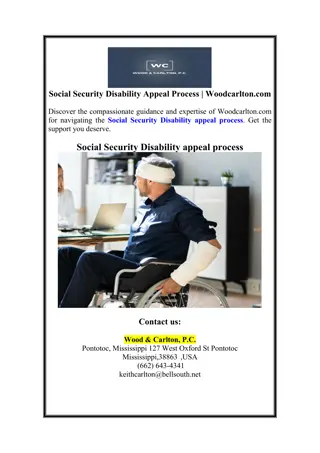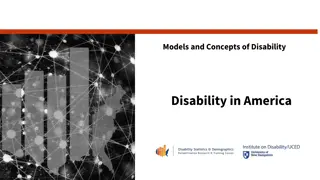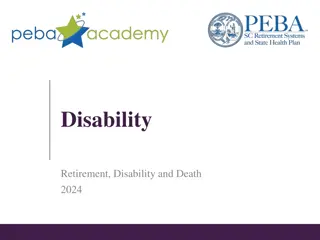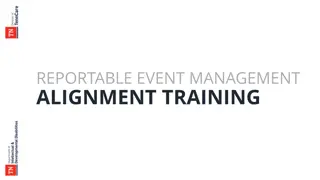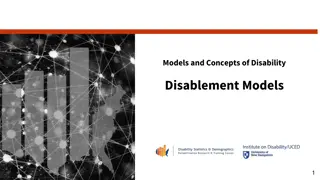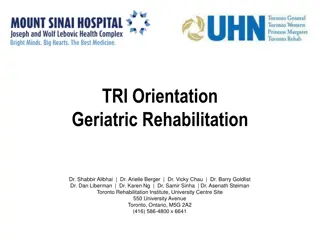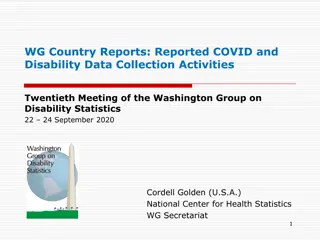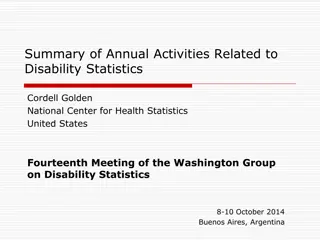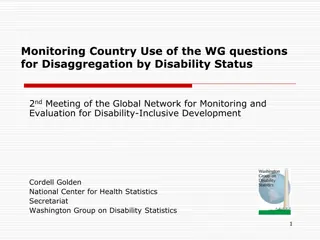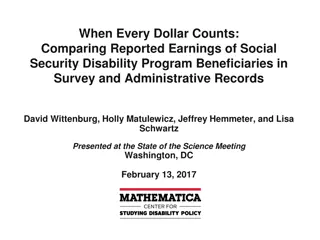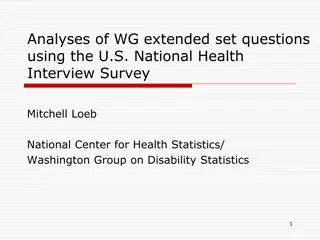Managing Social Security Disability Benefits for Provider Agencies
This comprehensive guide provides insights on managing Social Security Disability Benefits, debunking common myths, and outlining key details for reporting information to SSA. It covers important aspects such as the types of disability benefits, reporting requirements for Title II benefits, handling earned income, and best practices for reporting to SSA.
Download Presentation

Please find below an Image/Link to download the presentation.
The content on the website is provided AS IS for your information and personal use only. It may not be sold, licensed, or shared on other websites without obtaining consent from the author.If you encounter any issues during the download, it is possible that the publisher has removed the file from their server.
You are allowed to download the files provided on this website for personal or commercial use, subject to the condition that they are used lawfully. All files are the property of their respective owners.
The content on the website is provided AS IS for your information and personal use only. It may not be sold, licensed, or shared on other websites without obtaining consent from the author.
E N D
Presentation Transcript
MANAGING SOCIAL SECURITY DISABILITY BENEFITS: WHAT PROVIDER AGENCIES NEED TO KNOW Lucy Axton Miller Virginia Commonwealth University WIPA National Training & Data Center
COMMON MYTHS ABOUT SSA DISABILITY BENEFITS If SSA needs information from me, they will contact me. If I go to work, SSA knows what I earn because they are taking out the FICA. The check I am getting must be correct because I told SSA about all the income I am getting. When I need to report something to SSA I just call the toll-free line. If I don t know what I am supposed to report to SSA and I get overpaid, it s not my fault so I shouldn t have to pay it back.
THE TRUTH ABOUT MANAGING SSA DISABILITY BENEFITS There are two types of disability benefits SSI and the Title II disability benefits (SSDI, CDB and DWB). The two benefit programs operate very differently and both programs have their own rules about what information needs to be reported, when it needs to be reported, and how to report it. Some people get BOTH SSI and a form of Title II benefit so information needs to be reported twice according to each set of rules.
MANAGING TITLE II DISABILITY BENEFITS What needs to be reported? The Title II programs are NOT means-tested like SSI so there is no need to report changes in unearned income or resources. These programs are affected by earned income so wages or self-employment income must be reported. The #1 cause of overpayments in this program is unreported earnings!! There is more than one type of Title II disability benefit. Marriage does not affect SSDI, but it can have an impact on eligibility for CDB and DWB. Immigration status and incarceration affect all Title II benefits. Changes in disability status must be reported.
HOW SHOULD INFORMATION BE REPORTED TO SSA? While telephone options are available, reporting should be done in person at the local Field Office or in writing. Keep a copy of ALL correspondence received from and/or sent to SSA. If reporting is done in person, keep a log with dates, descriptions of what was reported and what instructions were provided, and the name of the SSA employee. If working, pay stubs should be mailed to SSA or submitted in person. A receipt should be provided.
REPORTING EARNED INCOME FOR A TITLE II BENEFICIARY Let s review how earned income is treated by SSDI/CDB/DWB: Gross earnings under $810 per month have no impact on benefits and use no work incentives. Gross earnings over $810 per month will trigger usage of Trial Work Period months. During the TWP, beneficiaries can earn an unlimited amount and be guaranteed to retain benefits. If the TWP ends, SSA will evaluate earnings to see if the beneficiary is engaging in Substantial Gainful Activity (SGA). Countable earnings over $1,130 in 2016 would be considered SGA. Beneficiaries who earn less than the SGA guideline will never lose benefits due to work. 1. 2. 3. 4.
REPORTING EARNED INCOME FOR A TITLE II BENEFICIARY Step 1: Start by reporting the start of employment or self- employment in WRITING! Give SSA all the information they need by using the Notice of Change in Earnings Status. Keep a copy and mail the original to the local Field Office. Step 2: Help the beneficiary complete the Work Activity Report (Form SSA-820/821). Be sure to warn the beneficiary that a form will be coming in the mail and to call you when it arrives! Keep a copy! Step 3: Save all pay stubs and evidence of IRWE/Subsidy and submit it to SSA in one package near the end of the TWP so that an SGA determination may be made. Step 4: Continue to retain all wage information and submit it to SSA whenever requested or when wages should cause a benefits change.
MORE SUGGESTIONS FOR HELPING WITH WAGE REPORTING Refer ALL working beneficiaries to the local WIPA Project for benefits counseling. Benefits counseling should begin BEFORE the person starts working, if possible. WIPA projects do NOT report for beneficiaries. They teach beneficiaries how to report correctly, provide support with managing benefits, and help resolve problems. The current WIPA Project in Louisville is operated by the Center for Accessible Living. Call 589-6620.
MANAGING SSI BENEFITS SSI is a form of federal welfare which is very strictly means-tested. All countable forms of income and resources are considered during eligibility determinations. SSI eligibility and payment amounts are determined on a month-by-month basis. SSI payments are reduced by how much countable income the beneficiary has using a standard formula. The maximum SSI payment for an individual in 2016 is $733. Each calendar year, SSA conducts an annual redetermination of all SSI recipients. They review all income, resources and other factors to make sure the payments received were correct. If too much SSI was paid, the individual typically will be required to pay the overage back.
WHAT NEEDS TO BE REPORTED IN THE SSI PROGRAM All forms of earned income (cash or in-kind) All forms of unearned income (cash or in-kind) Changes in living arrangement Assistance with food and shelter Changes in marital status All forms of resources (includes cash or property) and transfers of resources Detailed information about SSI and income is here: http://www.vcu-ntc.org/resources/viewContent.cfm/711 Detailed information about SSI and resources is here: http://www.vcu-ntc.org/resources/viewContent.cfm/710
REPORTING IN THE SSI PROGRAM All changes in reportable events need to be communicated to SSA. Make sure beneficiaries KNOW what needs to be reported! Monthly income affects the amount of the SSI cash payment, so income changes should be reported promptly to avoid over or under payments. It takes approximately two months for a change to be made in the SSI cash payment. The check received this month reflects the income status from 2 months prior.
WAYS TO REPORT WAGES IN THE SSI PROGRAM Reports may be: Mailed to the local Field Office Faxed to the local Field Office Delivered to SSA in person Submitted using the automated wage reporting system Reporting over the phone by calling the main SSA toll-free number or the local Field Office is NOT recommended! Beneficiaries need to keep copies of everything they submit to SSA.
SHOULD SSI RECIPIENTS SEND IN PAY STUBS EVERY MONTH? Some Field Offices want wage information to be submitted each month, while others prefer to use wage estimates and to verify using actual wage data on a periodic basis. ASK your local Field Office what they prefer don t assume! Help beneficiaries comply with the reporting procedures the local Field Office prefers. This means making sure they understand how to retain wage information and when/how to submit it to SSA. Help develop accurate wage estimates when needed and be sure to adjust the estimate if the beneficiary s status changes.
AUTOMATED WAGE REPORTING SSA has introduced a new system to facilitate wage reporting in the SSI program. This reporting system is known as the SSI Automated Telephone Wage Reporting System or SSITWR. Wage reports are made by phone using a dedicated toll free line which processes information automatically SSITWR does not work for beneficiaries who have wage deductions due to use of work incentives (BWEs, IRWEs, or PASS) A factsheet about the wage reporting system can be found online at: http://www.ssa.gov/ssi/spotlights/spot-telephone- wage.htm
GOOD CANDIDATES FOR SSITWR SSI beneficiaries with no work incentive deductions other than the Student Earned Income Exclusion Parents or spouses of SSI recipients who are not disabled and have income that will be deemed to the recipient. NOTE: Concurrent beneficiaries may use the SSITWR for the SSI benefits, but the automated report does not meet the Title II program reporting responsibilities. A separate report of wages will need to be made.
WHO MAY NOT USE THE SSITWR SYSTEM Beneficiaries who have Impairment Related Work Expenses (IRWEs) ; Beneficiaries who meet the definition of statutory blindness and may have Blind Work Expenses(BWEs); Beneficiaries who have a Plan to Achieve Self- Support; Beneficiaries who are not working, but who have income other than wages, including in-kind support and maintenance, deemed income, or unearned income; and Beneficiaries with more than one employer in a month.
AUTOMATED WAGE REPORTING IS NOT REQUIRED! Even if a beneficiary CAN use the system, they are not required to do so. Telephone reports using the SSI TWR system MUST be made within the first 6 days of the month. If the automated wage report time-frame is missed, or the person is ineligible to use the system, use traditional methods to report that month s earnings.
THE INDIVIDUAL PLACING THE CALL MUST BE ABLE TO: clearly speak first and last name information, understand requests for information given by the automated system, and Either speak, or use the telephone key-pad to enter, date of birth and social security number information.
EMPHASIZE TO THE INDIVIDUAL THAT: They must call the telephone number between the 1st and 6th of the month following the month in which the wages were received; the name to be used for authentication is the name that is on their most recent Social Security card; and if they are reporting wages for another individual (e.g. a representative payee reporting for a beneficiary) they will need their own name, Social Security Number (SSN), and date of birth information, as well as, the SSN information for the beneficiary.
IF REPORTING BY MAIL OR FAX Tell beneficiary to include: Pay stubs or print outs of wages provided by employer Receipts for work incentive usage. Letter identifying beneficiary by SSN, address and phone. SSN on which benefits are being paid if different from the beneficiary s SSN. Be sure to keep a copy of all correspondence sent to or received from SSA.
FINAL WORDS Anything that can go wrong will go wrong. Never assume that Social Security has explained what needs to be reported or how to report they haven t! Watch the check to make sure it is adjusted properly. Never assume that the check amount is correct. Overpayments are very common. They are inconvenient, but can be dealt with. Keep a copy of ALL correspondence!
